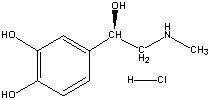
NTP Study Reports

NTP Study Reports
Home » Study Results & Research Projects » NTP Study Reports » All Long-Term Reports » Abstract for TR-380 - l-Epinephrine Hydrochloride

| Chemical Formula: C9H13NO3H Cl | - | 3D Structure* |
|---|---|---|
| *To view structure, download free Chemscape Chime Plug-in | ||
l-Epinephrine,an endogenous neurotransmitter hormone, is widely used for the treatment ofallergic and respiratory disorders. Toxicology and carcinogenesis studies ofepinephrine hydrochloride were conducted by exposing groups of F344/N ratsandB6C3F1 mice of each sex to an aerosol containing epinephrine hydrochloridefor14 days, 13 weeks, 15 months, or 2 years. During the 14-dayand 13-week studies, control animals were exposed to dilute aerosols ofhydrochloric acid (pH 2.8), whereas during the 15-month and 2-yearstudies, controls were exposed to aerosols of water. Genetic toxicologystudies of epinephrine were conducted in Salmonella typhimurium andChinese hamster ovary (CHO) cells.
Rats and mice were exposed to 0 or 12.5-200 mg/m3epinephrine hydrochloride. Deaths occurred in male rats exposed to 12.5mg/m3 or more and in females exposed to 25mg/m3 or more.Deaths of mice occurred at concentrations of 50 mg/m3 orhigher.Compound-related clinical signs included an increased respiratory rate in allgroups of epinephrine-exposedrats and mice. At higher concentrations (100 and 200 mg/m3),excessive lacrimation and dyspnea in rats and exaggerated visual andauditoryreflexes in mice were observed.
Rats and mice were exposed to 0 or 2.5-40 mg/m3epinephrinehydrochloride. Deaths in rats and mice were not concentration related. Finalmean body weights of chemically exposed and hydrochloric acid aerosolcontrolrats and mice were generally similar. Increased respiratory rates were notedin rats and mice exposed to 40 mg/m3. Heart and adrenal glandweights of rats and mice and liver weights of mice exposed to 40mg/m3 were greater than those of aerosol controls. Squamousmetaplasia occurred in the respiratory epithelium of the nasal mucosa of ratsand mice exposed to 40 mg/m3. Degenerative lesions of thelaryngealmuscle were seen in male and female rats exposed to 20 or 40mg/m3.Inflammation in the glandular stomach was seen in male and female miceexposedto 10, 20, and 40 mg/m3, and uterine atrophy was seen in 7/10femalemice exposed to 40 mg/m3.
Two-yearstudies were conducted by exposing groups of 60 rats or each sex to 0, 1.5, or5 mg/m3 epinephrine hydrochloride, 5 days per week for 103weeks.Groups of 60 mice of each sex were exposed to 0, 1.5, or 3mg/m3epinephrine hydrochloride, 5 days per week for 104 weeks. Use of theseexposureconcentrations represented a departure from the usual practice of utilizingdoses equivalent to one-half the maximum tolerated dose (MTD) and theMTD for 2-yearcarcinogenicity studies. Thus, although the dose levels exceeded maximumhumantherapeutic use levels (normalized to body weight and surface area), theywereless than one-halfthe MTD.
Results of hematologic analyses did not show compound-relatedchanges. Absolute liver weights for exposed mice (3 mg/m3)and rats(5 mg/m3) and relative liver weights for exposed rats (5mg/m3) were significantly lower than those for controls. Theabsolute kidney weights for mice exposed to 3 mg/m3 and thekidneyweight to body weight ratio for male mice exposed to 3 mg/m3weresignificantly lower than those for controls. No compound-relatedlesions were seen in rats or mice.
Mean body weights and survival of exposed and control rats andmicewere similar (survival, rats--male:control, 33/50; 1.5 mg/m3, 27/50; 5 mg/m3, 32/50;female:32/50; 29/50; 30/50; mice--male:control, 33/50; 1.5 mg/m3, 34/50; 3 mg/m3, 36/50;female:32/50; 35/50; 34/50).
Suppurative inflammation of the nasal mucosa, dilatation of the nasalglands (Bowman's and septal), and hyperplasia of the respiratory epitheliumwere seen at increased incidences in male rats exposed to 5mg/m3and in female rats exposed to 1.5 or 5 mg/m3.
Hyaline degeneration of the olfactory epithelium in male mice and suppurativeinflammation of the nasal passage and hyaline degeneration of the respiratoryepithelium in female mice were increased in the 1.5 and 3 mg/m3groups compared with controls. No neoplasms seen in these studies wereconsidered related to chemical exposure.
Salmonella gene mutation tests with l-epinephrineyielded negative results in strain TA100 in the presence of exogenousmetabolicactivation (S9) and equivocal results in the absence of S9. No mutagenicactivity was observed in strains TA98, TA1535, or TA1537 with or without S9.The responses observed in the CHO cell assay for induction of sisterchromatidexchanges were considered to be negative and equivocal in the presence andabsence of S9 activation, respectively. l-Epinephrinedid not induce chromosomal aberrations in CHO cells with or without S9.
Under the conditions of these 2-yearstudies, no carcinogenic effects were observed in male or female F344/N ratsexposed to aerosols containing 1.5 or 5 mg/m3l-epinephrinehydrochloride for 2 years or in B6C3F1 mice exposed to 1.5 or 3mg/m3 l-epinephrinehydrochloride for 2 years. However, these studies were considered to beinadequate studies of carcinogenic activity because the concentrationsused, which were chosen to represent multiples of therapeutic doses, wereconsidered too low for the animals to have received an adequate systemicchallenge from the compound.
Synonyms: adrenaline hydrochloride;4-(1-hydroxy-2-(methylamino)ethyl)-1,2-benzenediol;(-)3,4-dihydroxy-a-((methylamino)methyl)benzyl alcoholhydrochloride;methylaminoethanol catechol hydrochloride
Trade names for epinephrine formulations: Primatene®. Mist;Sus-Phrine®.;Epipen®.; Supravenin Hydrochloride®.; Bronkaid®.
Report Date: March 1990
Pathology Tables, Survival and Growth Curves from NTP 2-year Studies
Target Organs & Incidences from 2-year Studies
You may link to the full technical report in pdf format ( Note: A print ready copy of the document is presented in Portable Document Format (pdf) which requires the Acrobat Reader plug-in -- download a free copy of the reader.)
Web page last updated on October 02, 2007
The National Institute of Environmental Health Sciences is one of the National Institutes of Health within the U.S. Department of Health and Human Services. The National Toxicology Program is headquartered on the NIEHS campus in Research Triangle Park, NC.